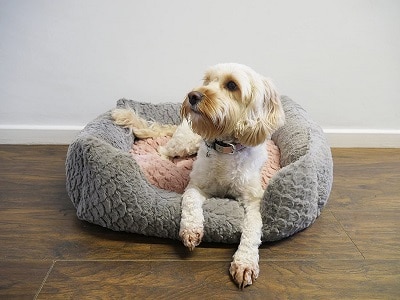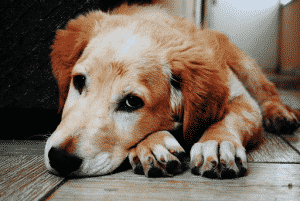A dog’s bed is a BIG deal. An adult dog generally spends 8 to 12 hours on their bed, while puppies and seniors spend 18 to 20 hours daily. Certain breeds like bulldogs and most hounds can lounge on a comfortable bed all day given the opportunity.
Given all that time your furball will be snoozing and re-energizing on their bed, you want it to be a source of great comfort. Some dogowners go for cheaper options, but trust me – skimping on quality will cost you in the end. You don’t need a top-of-the-line variety, but you should opt for bed quality over a cheapy budget.
Just like your mattress, a dog bed is an investment that’ll pays off for you and your furbaby. If you keep it clean, a good-quality bed lasts for years. In comparison, cheaper dog beds are neither comfortable nor durable. But if you do go for something off-brand, it’s important to stay vigilant for signs of damage.
How often should you get a new dog bed?
Dog beds are generally only good for one to five years, depending on the quality of the bed, your dog’s level of activity and how well you do cleaning & maintenance. A bed can technically last more than five years with proper care, but that would likely pose a health hazard.
Your doggo’s bed will suffer from regular wear and tear with time. It won’t be as firm as it was on day 1, so you shouldn’t use a bed for more than five years.
Here’s how to figure out if your dog’s bed needs a replacement:
1. An infestation can cause multiple health problems.
The bed is prone to two major infestation types – mange (mites) and parasitic (like worms, fleas, ticks). In an unlikely scenario, a pest infestation (cockroaches, spiders or ants) is also possible.
These infestations can happen for several reasons. It could be because your dog often plays in the mud and isn’t properly cleaned before bed. You might not disinfect their bed at regular intervals.
Regardless, the results can be drastic – from stomach ache to a sudden vet visit. When you notice an infestation, get your doggo checked and remedy the situation immediately. But don’t take too long. If Plan A and B fail, just get a new bed to be on the safer side.
2. Bacterias and unpleasant odours thrive in certain environments.
You must always keep your dog’s bed and the surrounding area clean. Disinfecting both constantly is the key to your dog’s health. Although, over time, some bacteria will find their way through the cracks, often indicated by god-awful odours.
Remedy the situation immediately as soon as you smell weird odours from your dog’s bed. Also, Some materials used to make dog beds have the downside of trapping stubborn odours over time.
With no bacteria to clean, your only choice is to get a replacement. That’s why five years is a hard stop for most dog beds.
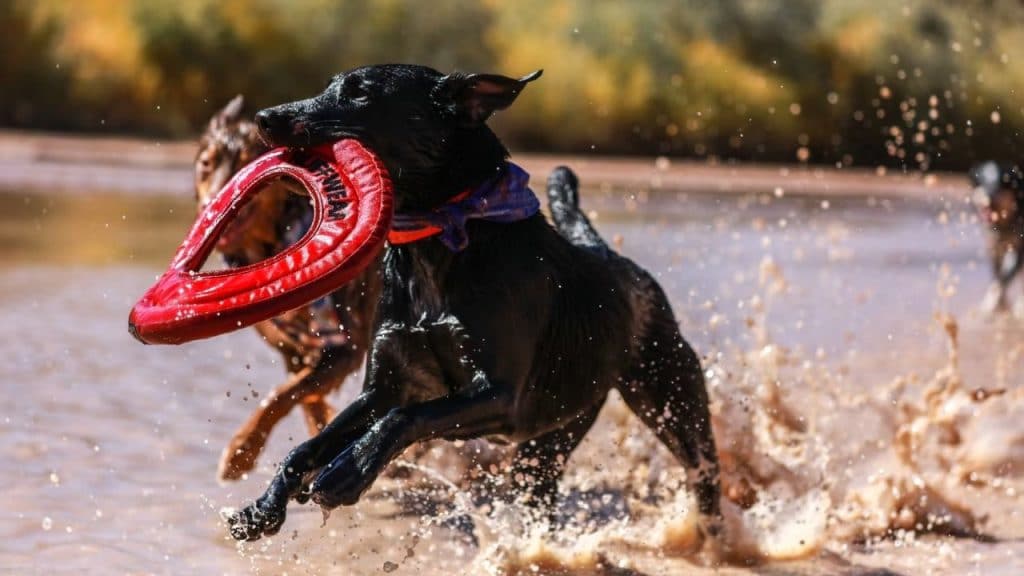
3. Invisible infestations are even worse.
Bad smell aside, a bacterial infection in dogs is way worse than in humans. It can lead to unexplained sickness (like stomach and ENT infections), rashes all over the body, and even excessive hair loss.
If your dogs get sick out of nowhere and too frequently, clean and disinfect their beds immediately. If all efforts fail, get a new bed and disinfect the entire area.
4. Wear and tear may lead to a choking hazard.
I know it sounds absurd, but it actually isn’t. You have to understand dogs are more sensitive than humans regarding overall health.
Dogs, and most other canines, have a natural instinct to claw on their bed before lying down. This will slowly tear the seams of their bed apart. A few tears and holes aren’t as big a problem here and there.
However, as soon as you see a hole big enough to fit your pup’s head inside, you must immediately replace their bed. Dogs are curious creatures, and they’ll eventually bury their head inside the hole.
Loose strings are just as bad. Your dog may start chewing on the seams out of curiosity and may accidentally choke on them.
5. Your dog’s needs have outgrown the current bed.
Obviously, I don’t need to tell you that a dog bed for a 6-month-old puppy will not fit an adult dog. But there’s more.
Due to health reasons, your dog might require a special bed with memory foam, orthopaedic support, and bolsters. With the amount of time your pooch will spend on their bed, you don’t want to take chances. Especially when it concerns senior dogs.
Read More: Beginner’s Guide to Preparing Dog Crates: What to add and where to put it?
How do you transition a dog to a new bed?
There are three major ways to help your dog transition smoothly to a new bed.
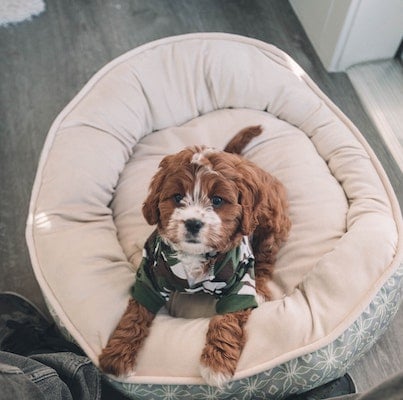
A. Facilitate the discovery.
Don’t shove the new bed down your dog’s throat. Instead, use treats to lure them in and let them discover it independently.
B. Hit the nostalgic nerve.
Dogs are creatures of habit and have a great sense of smell. After discovery, you want your dog to maintain that connection. Put the new bed in the old one’s spot, and use the same sheets and toys to make them feel at “home.”
C. Going to the new bed equals “good job!”
Use positive reinforcement to help them acclimate to their new bed.
1. How many beds should a dog have?
Your dog doesn’t need more than one bed, provided it’s comfortable and suits its physique and sleeping style. Some dogowners buy two beds – a mattress-like dog bed for the floor and one raised for the summer season. However, that’s not a necessity for every dog.
2. Do dogs prefer hard or soft beds?
Dogs prefer for their bedding to be firm – neither too soft nor hard. Firm bedding with memory-foam filling can support your pup’s posture and health. A bed that’s too soft or too hard, like a floor, can be tough on your dog’s joints in the long run.
3. Which fabrics are good for dog beds?
Microfiber, vinyl and nylon are the best fabrics for dog beds, followed by leather. Waterproof and outdoors-y fabrics do well because of how hyperactive dogs are. On the contrary, natural fabrics like silk, velvet and cotton are the worst.
Read More: Best Waterproof Dog Beds to Buy in the UK in 2022
How to maintain a dog bed for prolonged usage?
There are many ways to prolong your dog’s bed life cycle. First, keep the area squeaky clean. Regularly clean and disinfect the floor, walls and bed.
Here are some tips:
- Invest in washable dog bed covers.
- After washing, place the bed in sunlight to destroy bacteria.
- Wash your dog, especially your paws, after they come from outside.
- Vacuum it every day or on alternate days.
1. How often should you clean a dog’s bed?
Ideally, you should clean your dog’s bed every week or fortnightly. The biweekly schedule works well with quaint and senior dogs who aren’t as hyperactive and keep their bedding clean. However, to be safe, you should get a washable cover and cleaning every week.
2. How do you wash a dog’s bed?
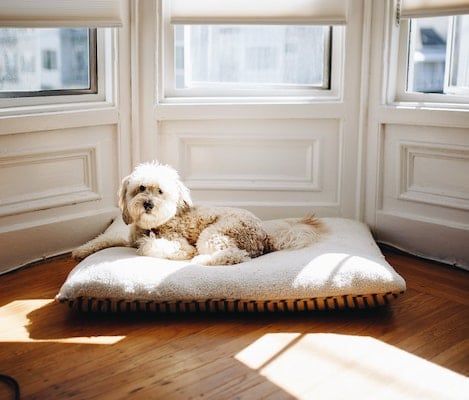
Cleaning a dog’s bed and surrounding area is a 4-step process.
Step 1: Hair Removal
Remove the massive amount of dog fur on the bed. There are a few ways of doing so that you can try one by one. Start with a lint brush or a wet cloth to remove surface-level hair.
Next, put it in a drier for about 10 minutes to soften the outer layer and loosen the hair. Then, finish off the job with a good, strong shake.
Step 2: Cleaning & Washing
If the stains are mild, use a brush and pet-friendly detergent. This also helps eliminate the odour.
If there’s stubborn stains, use a pet-friendly enzyme cleaner. Avoid vinegar-based home remedies if you’re using an enzyme cleaner.
Step 3: Drying & Disinfection
Read the product label and dry accordingly. The goal is to prevent damage and avoid shrinking the bedding, so don’t mess around with random methods. If allowed, let it dry in the sunlight for added disinfection.
Step 4: Clean the spot.
While it’s drying, clean and disinfect the floor and walls around your pup’s sleeping spot.
Why do dogs paw their beds before lying down?
Pawing their bed before lying down is a natural canine instinct. “Clawing into the dirt/ground below” is how dogs and other canines prepare a makeshift bed for sleeping outdoors. It’s for comfort and marking territory.
However, if it’s repeated too often or you notice something suspicious, check their bed for a flea infestation. They could also be frustrated or stressed with something else and take it out on their bed.
Read More: Why do dogs scratch at their beds?
